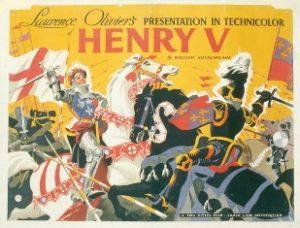The item we have chosen to write about is a poster for the 1944 film Henry V, directed by and starring Laurence Olivier. It is a film adaptation in Technicolor of the Shakespeare play of the same name. The film was released near the end of World War 2 and so was intended to lift the spirits of British civilians and soldiers, with the British government even funding part of the film. Churchill himself instructed Olivier to create the film as a morale booster. It was critically acclaimed at the time and has maintained this reputation, even being ranked 75th on Military History Magazine’s list of the 100 Greatest War Movies.
World War 2 had an enormous impact on the global film industry, with countless war movies being made during this period. Many of these, such as Henry V, could be classed as propaganda. The plot of Henry V involves the English army triumphing against the odds, and Henry himself gives multiple rousing speeches which motivate his men. We can therefore see why a film such as this may be made in wartime, as propaganda was needed to help the war effort.
Henry V may have been made to be seen mainly by British soldiers as they were the ones who were involved in the fighting, but it is likely that it was also intended to rouse civilians such as women who worked in factories to make things such as ammunition. Soldiers who were fighting abroad would not have been able to see the film when it was first released, and so it was probably intended to boost the morale of the British people in general, even those who were not directly involved in the war.
This item is important as it not only shows us how successful war films were at the time, but it also changes the way we think about propaganda. We often think of propaganda as government made, short informational films such as those encouraging people to join the army or grow their own potatoes, rather than a feature length adaptation of a Shakespeare play.
A limitation of the item’s usefulness is that while it may relate to World War 2, it is not directly about the war and so we must use other sources to see how it affected wartime cinema and culture. This can prove challenging, especially as many historical sources from this era are likely to be biased. Nevertheless, this poster is still an important item which can be used to educate us about cinema in World War 2.

TUTOR FEEDBACK
This is an excellent choice of item well suited to the task. The group show some good research around the film and the way it relates to war time contexts, and make some relevant observations about its patriotic, morale-boosting objectives and potential. The analysis of the source itself is good with some engaged remarks about how it makes us reconsider what we understand by propaganda, and the comments on its limitations show some good initial consideration of how a source cannot tell us everything / needs to be further contextualised. Overall, a great start to working with and writing about primary source material. For future work of this kind you could take it a little further — looking in greater detail at the object itself and analysing its imagery and text or thinking about how a poster might have been used (where it might have been featured etc.).